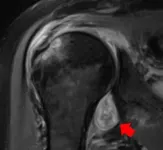(Press-News.org) SAN FRANCISCO, CA--February 16, 2021--In people with central nervous system (CNS) lymphoma, cancerous B cells--a type of white blood cell--accumulate to form tumors in the brain or spinal cord, often in close proximity to blood vessels. This disease is quite rare, but individuals who are affected have limited treatment options and often experience recurrence.
Previous research has linked the severity of CNS lymphoma to abnormal leaks in the blood-brain barrier, a protective system that allows some substances to pass from the bloodstream to the brain, while blocking others. However, the specific molecular details of this link have been murky.
Now, Gladstone researchers have shown in mice that CNS B-cell lymphoma cells cluster at sites where there is a leak in the blood-brain barrier. They also found that a blood protein called fibrinogen, which normally participates in blood clotting, promotes this clustering.
"Our findings link, for the first time, fibrinogen with CNS B-cell lymphoma, shedding new light on mechanisms of lymphoma growth in the brain that could be further explored as a treatment target," says senior author Jae Kyu Ryu, PhD, staff research scientist at Gladstone Institutes.
The study was just published in The American Journal of Pathology.
Homing in on Fibrinogen's Critical Role
CNS B-cell lymphoma is new territory for Ryu, but central to his research interest on the role of the blood-brain barrier in neurological diseases. His path to lymphoma research began when he and colleagues at Gladstone and UC San Francisco (UCSF) discovered that fibrinogen can leak through the blood-brain barrier in the brain of patients with B-cell lymphoma.
In parallel, James Rubenstein, MD, PhD, a professor at UCSF and co-author on the new study, had been studying the fluid that surrounds the brain and spinal cord to find clues on how B-cell lymphoma develops. He previously showed that, for patients with B-cell CNS lymphoma, this fluid harbors unusually high levels of proteins involved in blood clotting--including fibrinogen.
"With these clues in hand, I wanted to collaborate with Dr. Rubenstein and the UCSF Helen Diller Family Comprehensive Cancer Center and apply my expertise in blood-brain barrier leaks to determine more precisely how they might contribute to the development of CNS B-cell lymphoma," says Ryu, who is also an assistant professor of neurology at UCSF and a member of the newly founded Gladstone-UCSF Center for Neurovascular Brain Immunology.
In the first step of the study, the researchers observed abundant buildup of fibrinogen around CNS lymphoma tumors in tissues from both human patients and a mouse model of the disease. Thanks to bioinformatics tools, the scientists identified fibrinogen and other blood-clotting proteins in the brain fluid of B-cell lymphoma patients connected with tumor-associated alterations in biochemical pathways. Next, they used cutting-edge microscopy techniques to track cells in the mouse brains.
"Using live imaging of the mouse brain, we found that the cells accumulated at sites of leakage in the blood-brain barrier and tended not to stray from the leaks," says Justin Chan, first author of the study and undergraduate research intern at Gladstone, who is now a resident physician at the School of Medicine at the University of California, Irvine.
Tying it all together, the team finally showed that CNS lymphoma cells can stick to fibrinogen, but not to virtually every other protein found in mouse blood.
"That was kind of an ah-ha moment that pinpointed fibrinogen as a key protein that allows CNS B-cell lymphoma cells to adhere to the leakage sites in the brain," Ryu says.
"Fibrinogen is a common thread among multiple neurological and peripheral inflammatory diseases," says study co-author Katerina Akassoglou, PhD, who is the director of the Gladstone-UCSF Center of Neurovascular Brain Immunology, a senior investigator at Gladstone, and a professor of neurology at UCSF. "The new findings may reveal unanticipated mechanisms at the intersection of the vascular, brain, and immune interface in brain B-cell lymphoma, as well as novel targets for therapies and biomarkers."
An Attractive New Target for Lymphoma Treatment
The study's results suggest that fibrinogen could potentially be targeted to treat CNS B-cell lymphoma. Existing drugs that disrupt fibrinogen's activity may at first seem an appealing option. However, these drugs could excessively disturb the protein's beneficial blood-clotting role and lead to dangerous side effects, such as increased risk of tumor metastasis.
However, Ryu and colleagues are uniquely qualified to tackle this challenge: they have already developed an immunotherapy that blocks the specific role played by fibrinogen in neurological diseases, without disrupting the blood-clotting process.
The next step will be to better understand the molecular pathway by which fibrinogen promotes B-cell lymphoma in the brain, and to determine whether that role can be separated from the blood-clotting process.
"Our new findings provide an exciting foundation for future studies on developing strategies to precisely block the lymphoma-promoting activity of fibrinogen," adds Ryu. "This could help us identify very specific aspects of fibrinogen's activity that could be targeted safely and effectively."
INFORMATION:
About the Study
The study, "Blood Coagulation Factor Fibrinogen in Tumor Pathogenesis of Central Nervous System B-Cell Lymphoma," was published on February 16 2021, by the journal The American Journal of Pathology: https://www.sciencedirect.com/science/article/pii/S0002944020305964.
Other authors on the study include Gladstone researchers Mario Merlini and Andrew Mendiola, and UCSF researcher Hua-Xin Gao.
The researchers were supported by the National Institute of Neurological Disorders and Stroke (grant R35NS097976), the National Cancer Institute (grant R01CA139?83?01A1), the Leukemia and Lymphoma Society, the National Multiple Sclerosis Society, Race to Erase MS, the American Heart Association, the Conrad N. Hilton Foundation, and the Simon Family Trust.
About Gladstone Institutes
To ensure our work does the greatest good, Gladstone Institutes (gladstone.org) focuses on conditions with profound medical, economic, and social impact--unsolved diseases. Gladstone is an independent, nonprofit life science research organization that uses visionary science and technology to overcome disease. It has an academic affiliation with the University of California, San Francisco.
Tsukuba, Japan - It's tough out there in the sea, as the widespread loss of complex marine communities is testament to. Researchers from Japan have discovered that ocean acidification favors degraded turf algal systems over corals and other algae, thanks to the help of feedback loops.
In a study published this month in Communications Biology, researchers from the University of Tsukuba have revealed that ocean acidification and feedback loops stabilize degraded turf algal systems, limiting the recruitment of coral and other algae.
Oceans are undergoing widespread changes as a result of human activities. These changes take the form of regime shifts - major, sudden and persistent changes in ecosystem structure and function. An example is the replacement of coral reefs and kelp ...
An estimated 1.1 billion people were living with untreated vision impairment in 2020, but researchers say more than 90 per cent of vision loss could be prevented or treated with existing, highly cost-effective interventions.
Published today in The Lancet Global Health, a new commission report on global eye health calls for eye care to be included in mainstream health services and development policies. It argues that this is essential to achieve the WHO goal of Universal Health Coverage (UHC) and the 2030 United Nations Sustainable Development Goals (SDGs).
Written by 73 leading experts from 25 countries, including University of ...
FEBRUARY 15, 2021, NEW YORK - A Ludwig Cancer Research study has identified a novel mechanism by which a type of cancer immunotherapy known as CTLA-4 blockade can disable suppressive immune cells to aid the destruction of certain tumors. The tumors in question are relatively less reliant on burning sugar through a biochemical process known as glycolysis.
Researchers led by Taha Merghoub and Jedd Wolchok of the Ludwig Center at Memorial Sloan Kettering Cancer Center (MSK) and former postdoc Roberta Zappasodi--now at Weill Cornell Medicine--have discovered that in a mouse model of glycolysis-deficient tumors, CTLA-4 blockade does ...
Durham, NC- Can stem cells alleviate lymphedema, a chronic debilitating condition affecting up to one in three women treated for breast cancer? Results of a phase I clinical trial released today in STEM CELLS Translational Medicine (SCTM) show there is a strong possibility that the answer is yes.
Lymphedema is swelling due to a build-up of fluid in lymph nodes - vessels that help rid the body of toxins, waste, and other unwanted materials- usually occurring in an arm or leg. While it can be the result of an inherited condition, its most common cause in the Western world is the removal of or damage to the lymph nodes during the course of cancer ...
CHICAGO --- Muscle soreness and achy joints are common symptoms among COVID-19 patients. But for some people, symptoms are more severe, long lasting and even bizarre, including rheumatoid arthritis flares, autoimmune myositis or "COVID toes."
A new Northwestern Medicine study has, for the first time, confirmed and illustrated the causes of these symptoms through radiological imaging.
"We've realized that the COVID virus can trigger the body to attack itself in different ways, which may lead to rheumatological issues that require lifelong management," said corresponding author Dr. Swati Deshmukh.
The paper will be published Feb. 17 in the journal Skeletal Radiology. The study is a retrospective review of data from patients who presented to Northwestern Memorial Hospital between ...
A woman's body shape--not only the amount of fat--is what drives stigma associated with overweight and obesity.
Fat stigma is a socially acceptable form of prejudice that contributes to poor medical outcomes and negatively affects educational and economic opportunities. But a new study has found that not all overweight and obese body shapes are equally stigmatized. Scientists from Arizona State University and Oklahoma State University have shown that women with abdominal fat around their midsection are more stigmatized than those with gluteofemoral fat on the hips, buttocks and thighs. The work will be published on February 17 in Social Psychology and Personality Science.
"Fat stigma is pervasive, painful and results ...
To provoke more interest and excitement for students and lecturers alike, a professor from Florida Atlantic University's College of Engineering and Computer Science is spicing up the study of complex differential mathematical equations using relevant history of algebra. In a paper published in the Journal of Humanistic Mathematics, Isaac Elishakoff, Ph.D., provides a refreshing perspective and a special "shout out" to Stephen Colbert, comedian and host of CBS's The Late Show with Stephen Colbert. His motivation? Colbert previously referred to mathematical equations as ...
Children are protected from severe COVID-19 because their innate immune system is quick to attack the virus, a new study has found.
The research led by the Murdoch Children's Research Institute (MCRI) and published in Nature Communications, found that specialised cells in a child's immune system rapidly target the new coronavirus (SARS-CoV-2).
MCRI's Dr Melanie Neeland said the reasons why children have mild COVID-19 disease compared to adults, and the immune mechanisms underpinning this protection, were unknown until this study.
"Children are less likely to become infected with the virus and up to a third are asymptomatic, which is strikingly different to ...
A new study, published in Bioscience, considers the future of ecology, where technological advancement towards a multidimensional science will continue to fundamentally shift the way we view, explore, and conceptualize the natural world.
The study, co-led by Greg Asner, Director of the Arizona State University Center for Global Discovery and Conservation Science, in collaboration with Auburn University, the Oxford Seascape Ecology Lab, and other partners, demonstrates how the integration of remotely sensed 3D information holds great potential to provide new ecological insights on land and in the oceans.
Scientific research into 3D digital applications in ecology has grown in the last decade. Landscape ...
With every passing day, human technology becomes more refined and we become slightly better equipped to look deeper into biological processes and molecular and cellular structures, thereby gaining greater understanding of mechanisms underlying diseases such as cancer, Alzheimer's, and others.
Today, nanoimaging, one such cutting-edge technology, is widely used to structurally characterize subcellular components and cellular molecules such as cholesterol and fatty acids. But it is not without its limitations, as Professor Dae Won Moon of Daegu Gyeongbuk Institute of Technology (DGIST), Korea, lead scientist in a recent groundbreaking study advancing the field, explains: "Most advanced nanoimaging techniques use accelerated electron or ion beams ...








